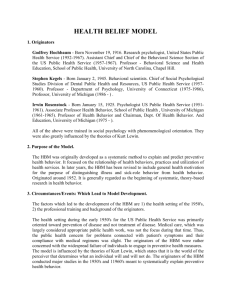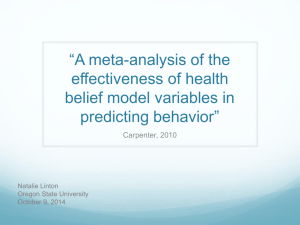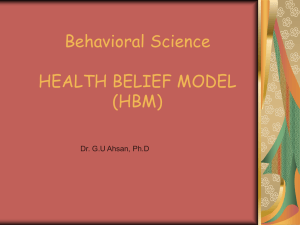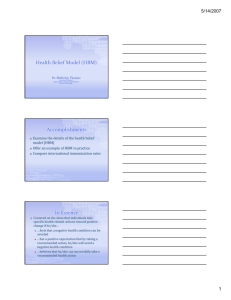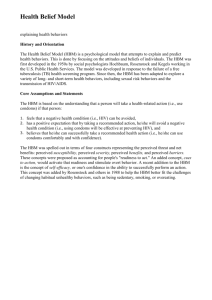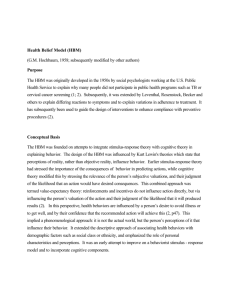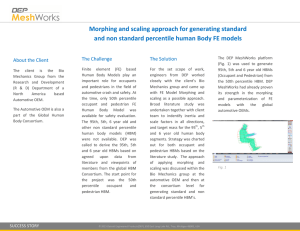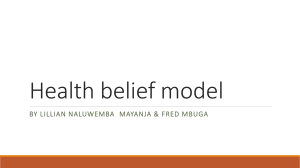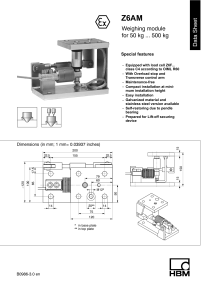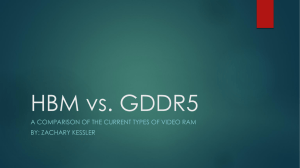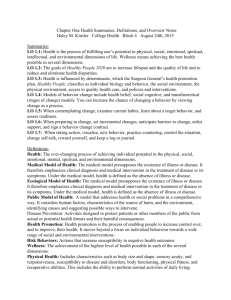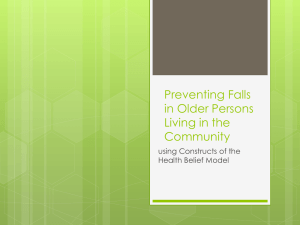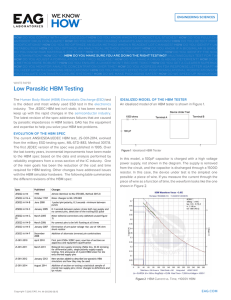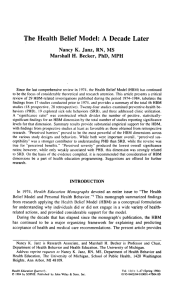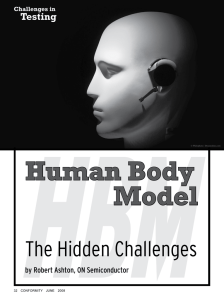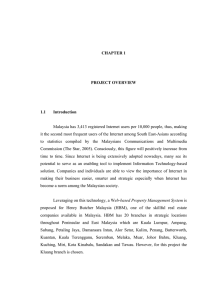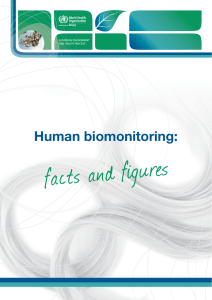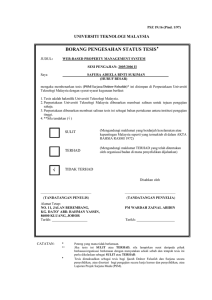health belief model
advertisement
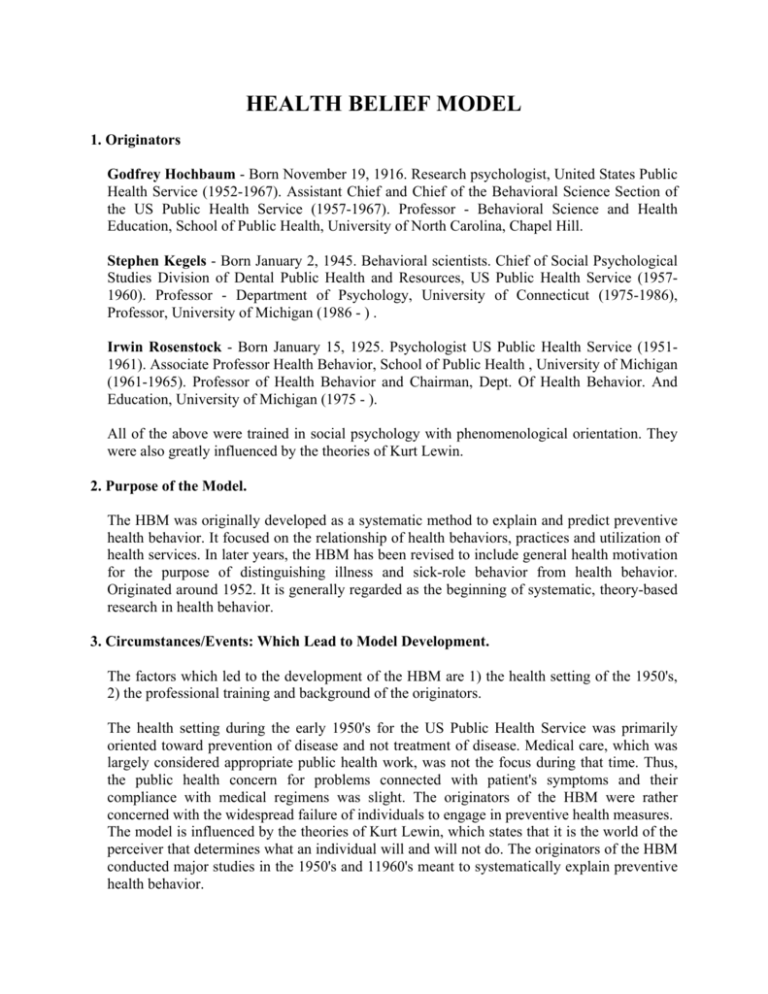
HEALTH BELIEF MODEL 1. Originators Godfrey Hochbaum - Born November 19, 1916. Research psychologist, United States Public Health Service (1952-1967). Assistant Chief and Chief of the Behavioral Science Section of the US Public Health Service (1957-1967). Professor - Behavioral Science and Health Education, School of Public Health, University of North Carolina, Chapel Hill. Stephen Kegels - Born January 2, 1945. Behavioral scientists. Chief of Social Psychological Studies Division of Dental Public Health and Resources, US Public Health Service (19571960). Professor - Department of Psychology, University of Connecticut (1975-1986), Professor, University of Michigan (1986 - ) . Irwin Rosenstock - Born January 15, 1925. Psychologist US Public Health Service (19511961). Associate Professor Health Behavior, School of Public Health , University of Michigan (1961-1965). Professor of Health Behavior and Chairman, Dept. Of Health Behavior. And Education, University of Michigan (1975 - ). All of the above were trained in social psychology with phenomenological orientation. They were also greatly influenced by the theories of Kurt Lewin. 2. Purpose of the Model. The HBM was originally developed as a systematic method to explain and predict preventive health behavior. It focused on the relationship of health behaviors, practices and utilization of health services. In later years, the HBM has been revised to include general health motivation for the purpose of distinguishing illness and sick-role behavior from health behavior. Originated around 1952. It is generally regarded as the beginning of systematic, theory-based research in health behavior. 3. Circumstances/Events: Which Lead to Model Development. The factors which led to the development of the HBM are 1) the health setting of the 1950's, 2) the professional training and background of the originators. The health setting during the early 1950's for the US Public Health Service was primarily oriented toward prevention of disease and not treatment of disease. Medical care, which was largely considered appropriate public health work, was not the focus during that time. Thus, the public health concern for problems connected with patient's symptoms and their compliance with medical regimens was slight. The originators of the HBM were rather concerned with the widespread failure of individuals to engage in preventive health measures. The model is influenced by the theories of Kurt Lewin, which states that it is the world of the perceiver that determines what an individual will and will not do. The originators of the HBM conducted major studies in the 1950's and 11960's meant to systematically explain preventive health behavior. Godfrey Hochbaum initiated the first research on the HBM in 1952 by an attempt to identify factors underlying the decision to obtain a chest x-ray for the early detection of TB. Thus, like Lewin, the early researchers also included in the model a strong component of the behaving individual's perceptual world. Later, researchers included motivation as a major component. Also a strong concentration on the individual's current dynamics, believing that prior experience exercises influence only insofar as it is still represented in the individual's present state of affairs. 4. Brief Description. The HBM attempts to predict health-related behavior in terms of certain belief patterns. Emphasis is placed on the above described categories. The model is used in explaining and predicting preventive health behavior, as well as sick-role and illness behavior. The HBM has been applied to all study all types of health behavior. A person's motivation to undertake a health behavior can be divided into three main categories: individual perceptions, modifying behaviors, and likelihood of action. Individual perceptions are factors that affect the perception of illness or disease, they deal with the importance of health to the individual, perceived susceptibility, and perceived severity. Modifying factors include demographic variables, perceived threat, and cues to action. The likelihood of action discusses factors in probability of appropriate health behavior; it is the likelihood of taking the recommended preventive health action. The combination of these factors causes a response that often manifests into action, provided it is accompanied by a rational alternative course of action. Other theories have contributed to the development of this theory. The Social Learning Theory contributes to the HBM in different ways: • Multiple sources for acquiring expectations • Learning through imitating others • Self-efficacy The HBM states that the perception of a personal health behavior threat is itself influenced by at least three factors: general health values, which include interest and concern about health; specific health beliefs about vulnerability to a particular health threat; and beliefs about the consequences of the health problem. Once an individual perceives a threat to his/her health and is simultaneously cued to action, and his/her perceived benefits outweighs his/her perceived benefits, then that individual is most likely to undertake the recommended preventive health action. There may be some variables (demographic, sociopsychological, and structural) that can influence an individual's decision. 5. Key Descriptors: Perceived Susceptibility - Each individual has his/her own perception of the likelihood of experiencing a condition that would adversely affect one's health. Individuals vary widely in their perception of susceptibility to a disease or condition. Those at low end of the extreme deny the possibility of contracting an adverse condition. Individuals in a moderate category admit to a statistical possibility of disease susceptibility. Those individuals at the high extreme of susceptibility feel there is real danger that they will experience an adverse condition or contract a given disease. Perceived Seriousness - refers to the beliefs a person holds concerning the effects a given disease or condition would have on one's state of affairs. These effects can be considered from the point of view of the difficulties that a disease would create. For instance, pain and discomfort, loss of work time, financial burdens, difficulties with family, relationships, and susceptibility to future conditions. It is important to include these emotional and financial burdens when considering the seriousness of a disease or condition. Perceived Benefits of Taking Action - taking action toward the prevention of disease or toward dealing with an illness is the next step to expect after an individual has accepted the susceptibility o f a disease and recognized it is serious. The direction of action that a person chooses will be influenced by the beliefs regarding the action. Barriers to Taking Action - However, action may not take place, even though an individual may believe that the benefits to taking action are effective. This may be due to barriers. Barriers relate to the characteristics of a treatment or preventive measure may be inconvenient, expensive, unpleasant, painful or upsetting. These characteristics may lead a person away from taking the desired action. Cues to Action - an individual's perception of the levels of susceptibility and seriousness provide the force to act. Benefits (minus barriers) provide the path of action. However, it may require a 'cue to action' for the desired behavior to occur. These cues may be internal or external. 6. Applications in Health Education: • • • Provide incentive to take action Provide clear course of action to acceptable cost Enhance feeling of competency to take action 7. Limitations One of the problems that has plagued the HBM is that different questions are used in different studies to determine the same beliefs; consequently, it is difficult both to design appropriate tests of the HBM and to compare results across studies. Another reason why research does not always support the HBM is that factors other than health beliefs also heavily influence health behavior practices. These factors may include: special influences, cultural factors, socioeconomic status, and previous experiences.
